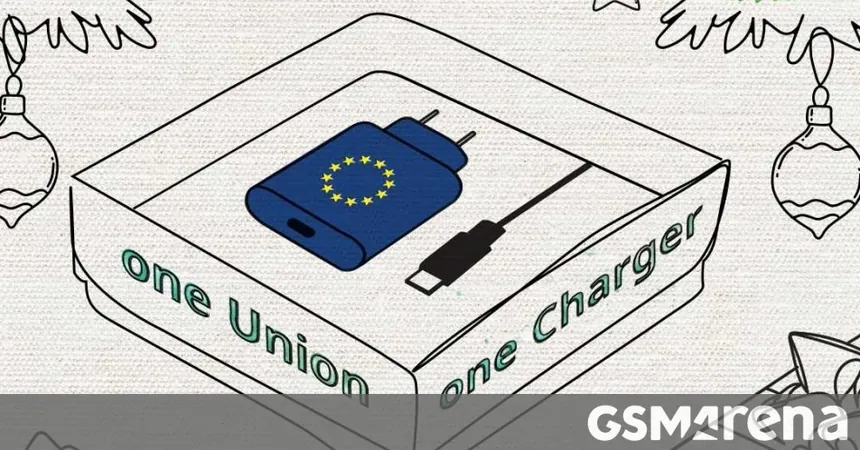
USB-C Charging Becomes Mandatory in the EU: What You Need to Know Now!
2024-12-30
Author: John Tan
In a monumental move towards sustainability
The European Union (EU) has officially implemented its USB-C directive, mandating that all mobile devices must adopt this universal charging port. This regulation aims not only to cut down on electronic waste (e-waste) but also to tackle the issues surrounding market fragmentation that has plagued consumers for years.
Background of the Directive
The European Commission revealed this decision in 2022, giving manufacturers until 2025 to ensure that all newly sold mobile phones across the EU utilize USB-C ports. Furthermore, all 27 EU member countries were required to incorporate this directive into their national laws by December 28 of the same year.
Devices Covered by the Directive
The directive encompasses a wide range of devices—including smartphones, tablets, digital cameras, headphones, handheld gaming consoles, and more—that can be charged through a wired connection and support power delivery of up to 100 watts. Notably, laptop manufacturers have until April 28, 2026, to implement the change, affording them an additional 16 months of flexibility to comply. However, devices such as the PlayStation 5, which demand higher power inputs, are not included in these regulations.
Exclusions and Future Evaluations
Interestingly, the directive does not cover all electronic gadgets. For instance, drones and wireless chargers remain outside its purview. The European Commission plans to continuously evaluate technological advancements and market trends to ensure that the list of covered devices remains current and relevant.
Manufacturers' Obligations
While manufacturers are required to provide USB-C ports, they may still utilize their proprietary charging solutions—like Apple's MacBooks—if they choose. Existing products without USB-C can remain on retail shelves, but manufacturers are barred from launching new devices lacking the mandatory port, and retailers will no longer be able to stock older models.
Standardizing Charging Solutions
One of the directive's pivotal components focuses on standardizing charging solutions. Any device that can be recharged with a wired connection and exceeds certain thresholds—specifically voltages over 5V, currents over 3A, or power greater than 15W—must adhere to the USB Power Delivery (USB-PD) standard. This means that popular models, such as iPhones and Google Pixels, will remain unaffected since they comply, but brands like OnePlus and Oppo must adhere to USB-PD standards or face removal from the market. Fortunately, these brands have been supporting USB-PD for some time now, making compliance smooth.
Impacts on Consumers
Crucially, the European Commission is allowing the sale of new electronic devices without bundled chargers. This initiative aims to mitigate the excessive waste generated by surplus chargers, which often remain unused and end up in landfills. Moving forward, consumers will find that smartphones sold in the EU will no longer include a charger in the box. To inform buyers, manufacturers will provide clear graphics on packaging indicating whether a charger is included, enhancing transparency for shoppers.
Global Implications
The implementation of such regulations raises questions about whether other global regions will follow suit. While it may be seen as a burden on manufacturers, this directive is a significant victory for consumers, reinforcing the EU's commitment to prioritizing citizen welfare over corporate interests.
Conclusion
In summary, as we approach these significant changes in the tech landscape, consumers can look forward to a more unified and eco-friendly charging experience, paving the way for a sustainable future in technology!
 Brasil (PT)
Brasil (PT)
 Canada (EN)
Canada (EN)
 Chile (ES)
Chile (ES)
 Česko (CS)
Česko (CS)
 대한민국 (KO)
대한민국 (KO)
 España (ES)
España (ES)
 France (FR)
France (FR)
 Hong Kong (EN)
Hong Kong (EN)
 Italia (IT)
Italia (IT)
 日本 (JA)
日本 (JA)
 Magyarország (HU)
Magyarország (HU)
 Norge (NO)
Norge (NO)
 Polska (PL)
Polska (PL)
 Schweiz (DE)
Schweiz (DE)
 Singapore (EN)
Singapore (EN)
 Sverige (SV)
Sverige (SV)
 Suomi (FI)
Suomi (FI)
 Türkiye (TR)
Türkiye (TR)
 الإمارات العربية المتحدة (AR)
الإمارات العربية المتحدة (AR)